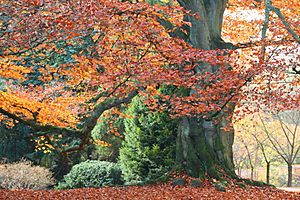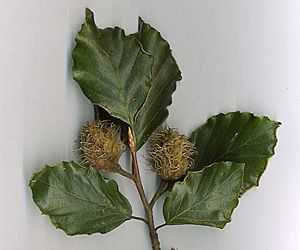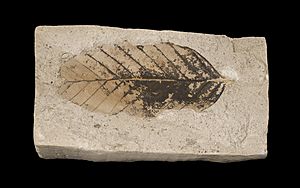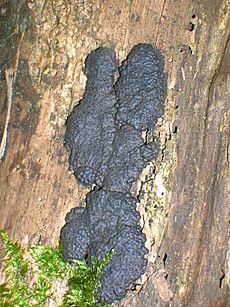European beech facts for kids
Quick facts for kids Fagus sylvaticaEuropean beech |
|
|---|---|
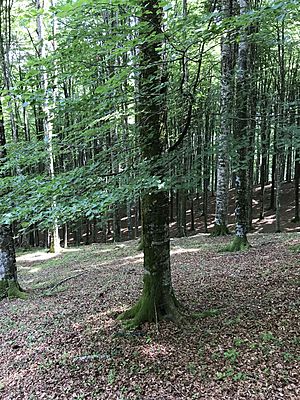 |
|
| European beech in an alpine forest (Italy) | |
| Conservation status | |
| Scientific classification | |
| Genus: |
Fagus
|
| Species: |
sylvatica
|
 |
|
| Distribution map | |
| Synonyms | |
|
|
The European beech or common beech (Fagus sylvatica) is a large deciduous tree. This means it loses its leaves every autumn. It belongs to the beech family, called Fagaceae.
Contents
About the European Beech Tree
The European beech is a very tall tree. It can grow up to 50 m (160 ft) high. Its trunk can be as wide as 3 m (9.8 ft). Most often, it reaches 25–35 m (82–115 ft) tall. A young tree, about 10 years old, will be around 4 m (13 ft) tall.
These trees usually live for 150 to 200 years. Some can even live up to 300 years! In forests, trees are often cut down when they are 80 to 120 years old. It takes about 30 years for a beech tree to grow fully.
The way a beech tree looks depends on where it grows. In thick forests, it grows very tall, over 30 m (100 ft). Its branches are high up on the trunk. In open areas, it is shorter, usually 15–24 m (50–80 ft). It also has a wider, more spread-out shape.
Leaves and Buds
The leaves grow in an alternating pattern along the branch. They are simple, meaning they are not divided into smaller leaflets. They are about 5–10 cm long and 3–7 cm wide. Each side of the leaf has 6–7 veins. The edges of the leaves can be smooth or slightly toothed.
The tree's buds are long and thin. They are about 15–30 mm (0.59–1.18 in) long. If a bud contains flowers, it will be thicker, about 4–5 mm (0.16–0.20 in).
Sometimes, beech leaves do not fall off in autumn. They stay on the tree until spring. This is called marcescence. It often happens with young trees or when the trees are trimmed as a hedge. This makes beech hedges good screens even in winter.
Flowers and Nuts
Beech trees can start making a few seeds when they are about 10 years old. But they don't produce many until they are at least 30 years old.
Male flowers grow in small hanging clusters called catkins. Female flowers grow into nuts called beechnuts. These nuts are small and triangular. They are about 15–20 millimetres (0.59–0.79 in) long. Each small, woody cup holds two nuts. The nuts ripen in autumn, about 5–6 months after the flowers are pollinated. The tree produces many flowers and seeds after a hot, sunny, and dry summer.
Where Does it Grow?
The European beech naturally grows across a wide area. This includes southern Sweden, northern Sicily, France, southern England, and parts of Portugal and Spain. It also grows east to northwest Turkey. In the southern parts of its range, like around the Mediterranean Sea, it only grows in mountain forests. Here, it is found at 600–1,800 m (1,969–5,906 ft) above sea level.
Some people think the European beech arrived in England around 4000 BC. This was 2,000 years after the English Channel formed. It might have been brought by Stone Age humans who ate the nuts. In southern England, it is seen as a native tree. But in the north, it is sometimes removed from forests because it's not considered native there.
The beech tree is not picky about the type of soil it grows in. However, it needs a humid climate with rain throughout the year and often fog. It also needs soil that drains well, as it cannot stand too much standing water. It likes soil that is moderately fertile, either chalky or slightly acidic. This is why you often find it on hillsides rather than in muddy valleys. It can handle cold winters but is sensitive to frost in spring.
Life in the Forest
The roots of the European beech are shallow and spread out in all directions. These trees work with certain fungi in the soil. These fungi help the tree get water and nutrients.
In southern Britain, beech trees are more common than oak and elm trees in many woodlands. One of the most beautiful European beech forests is the Sonian Forest in Belgium. Beech trees make up about 10% of all forests in France. The largest old-growth forests of beech trees are in Ukraine and Romania. These forests are home to large predators like brown bears, grey wolves, and lynx. Many trees in these forests are over 350 years old, and some are even 500 years old.
Reproduction and Life Cycle
European beech leaves start to grow in spring. This happens when the days get longer and the temperature rises. Buds usually open from mid-April to early May. This timing is very exact, often within a few days. It is more precise in the northern parts of its range.
The tree prepares for the next spring during summer and autumn. Good rainfall in summer helps decide how many leaves will be in the buds. In autumn, the tree stores energy for spring. If conditions are good, a bud can grow into a shoot with ten or more leaves. The top bud releases a hormone in spring that stops other buds from growing. This is very strong in young trees but gets weaker as trees get older.
New root growth starts only after the leaves begin to bud. The first roots are very thin. Later, after the tree grows above ground, thicker roots grow steadily.
A beech forest is very dark because the trees have dense leaves. Not many other plants can grow on the forest floor where the sun hardly reaches. Young beech trees prefer some shade. They might not grow well in full sunlight. If a forest is completely cut down, young beech trees might die from too much dryness. If they grow under oak trees with thin leaves, the beech trees will quickly grow taller. Because their leaves are so dense, the oak trees will then die from lack of sunlight.
Growing Beech Trees
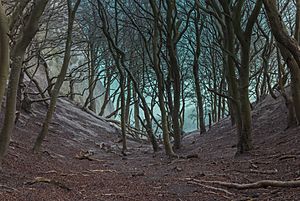
The European beech is a very popular tree for parks and large gardens. People in North America often prefer it over the native American beech. This is because the European beech grows faster. It takes about 10 years less to reach full size.
Beech trees are also often trimmed to make nice hedges.
Special Beech Varieties
Since the early 1800s, many special types of European beech trees have been created. These are called cultivars. Here are some examples:
- Copper beech or purple beech (Fagus sylvatica purpurea): This tree has purple leaves. It was first noticed in Germany in 1690. Almost all copper beeches in the world come from this one tree. Their leaves are purple, but some turn dark green by mid-summer.
- Fern-leaf beech (Fagus sylvatica Heterophylla Group): Its leaves are deeply cut or look like threads.
- Dwarf beech (Fagus sylvatica Tortuosa Group): This type has a unique twisted trunk and branches.
- Weeping beech (Fagus sylvatica Pendula Group): Its branches hang downwards.
- Dawyck beech (Fagus sylvatica 'Dawyck'): This tree grows tall and narrow like a column. It comes in green, gold, and purple forms. It is named after a garden in Scotland.
- Golden beech (Fagus sylvatica 'Zlatia'): Its leaves are golden in spring.
The following types have won an award called the Royal Horticultural Society's Award of Garden Merit:
- F. sylvatica
- 'Dawyck'
- 'Dawyck Gold'
- 'Dawyck Purple'
- 'Pendula' (weeping beech)
- 'Riversii'
- F. sylvatica var. heterophylla 'Aspleniifolia'
What is Beech Wood Used For?
The wood from the European beech is used to make many things. It has a fine grain, which means it is easy to work with. It can be soaked, dyed, varnished, and glued easily. Steaming the wood makes it even easier to shape. It looks great when finished and is strong against pressure and splitting. It is also stiff when bent.
Beech wood is great for making furniture, flooring, and staircases. It is not used for heavy building structures, especially outdoors, because it can rot easily. Its hardness makes it perfect for wooden mallets and workbench tops. It is also considered one of the best woods for firewood in fireplaces. The wood can also be used to make paper pulp. Its high cellulose can be turned into a fabric called modal, which is like cotton.
Other Cool Uses
The nuts of the beech tree can be eaten by humans and animals. If humans eat too many, they can be slightly harmful because they contain certain chemicals. However, in the 1800s, people in England pressed the nuts to get an oil. This oil was used for cooking and in lamps. The nuts were also ground into flour. People would soak the flour to remove the harmful chemicals before eating it.
A special smoke flavoring is also made from the European beech tree.
Pests and Diseases
Biscogniauxia nummularia is a type of fungus that attacks beech trees. It causes a disease called beech tarcrust. This disease makes parts of the tree rot. You can see this fungus on beech trees at any time of the year.
Image gallery
-
'Pendula', Harlow Carr.
-
The famous Upside-down Tree, Hyde Park, London, an example of F. sylvatica 'pendula'.
-
Leaves of var. heterophylla 'Aspleniifolia', Belfast Botanic Garden
-
Old stand of beech prepared for regeneration (note the young undergrowth) in the Sonian Forest.
Images for kids
See also
 In Spanish: Haya común para niños
In Spanish: Haya común para niños



